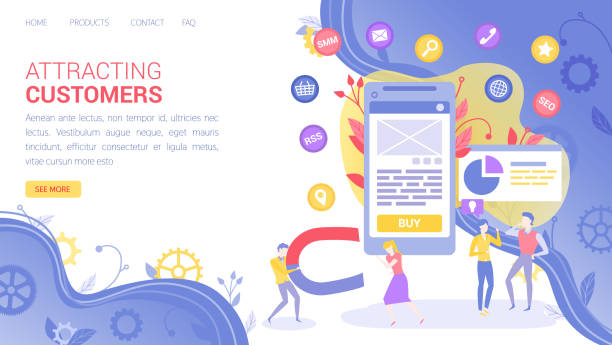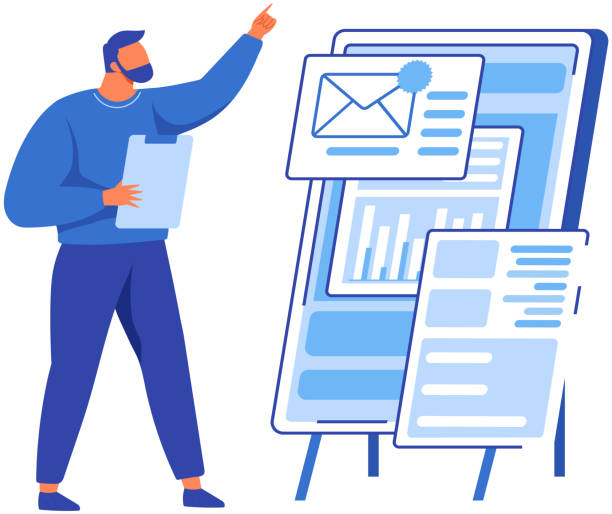Introduction to the Importance of Fast Website Design in Today’s Digital World

In this era where speed is paramount, fast website design is no longer a luxury option, but an absolute necessity.
Today’s users are absolutely unwilling to wait for web pages to load; any delay, even a few seconds, can lead to losing visitors, decreased sales, and serious damage to your #brand.
Statistics show that a large portion of users abandon a website if it takes more than three seconds to load.
This issue not only negatively impacts user experience, but is also directly related to your site’s ranking in search engines like Google.
Google has explicitly stated that website loading speed is one of the key factors in its ranking algorithms.
Therefore, every business and individual with an online presence must consider optimizing their website’s speed.
Building a high-speed website not only means greater customer satisfaction, but also improved SEO, increased conversion rates, and ultimately, greater success in the competitive web space.
This article descriptively and educationally addresses various aspects of fast website design and provides practical guidelines for achieving it.
Hence, awareness and action in this area are vital for every webmaster.
This introduction demonstrates why the discussion of high-performance web design has become more important than ever today.
Does your company’s website create a professional and lasting first impression in the minds of potential customers? Rasaweb, with its professional corporate website design, not only represents your brand’s credibility but also opens a path for your business growth.
✅ Create a powerful and reliable brand image
✅ Attract target customers and increase sales
⚡ Get free consultation
Key Factors Influencing Website Loading Speed

To achieve fast website design, we must first become familiar with the main factors that affect website loading speed.
These factors are very diverse and range from host selection to coding structure and content optimization.
One of the most important of these factors is hosting server quality.
Using a powerful server with sufficient bandwidth and dedicated resources can make a significant difference in loading speed.
Inefficient and heavy coding, especially excessive use of JavaScript libraries or unnecessary CSS, severely impacts speed.
Code optimization and removal of unnecessary elements are among the specialized solutions in this area.
The size and number of images are also important factors; high-volume images without proper compression can significantly reduce loading speed.
Additional plugins and extensions, especially in content management systems like WordPress, can place a heavy load on the server and slow down the site.
Choosing correctly and limiting the number of plugins is crucial.
Not using a CDN (Content Delivery Network) for content distribution worldwide can also cause loading delays for geographically distant users.
Also, not using caching mechanisms can force the browser to load the entire site content from scratch every time.
Each of these factors in some way affects your website performance and must be considered in the process of fast website design.
Essential Tools and Technologies for Speed Optimization

To achieve fast website design, using appropriate tools and technologies is of high importance.
One of the most important techniques is implementing strong caching.
Caching helps store temporary copies of your website so that on subsequent visits, there is no need to fully reload the page.
This can significantly reduce loading time.
Tools like WP Rocket for WordPress or Redis and Varnish for servers are examples of caching solutions.
The use of a CDN (Content Delivery Network) is also vital.
By distributing your website’s static content (such as images, CSS, and JavaScript) across various geographical servers, a CDN ensures users receive content from the server closest to them, thereby increasing loading speed.
Cloudflare and Akamai are among the popular CDNs.
Image and file compression is also a fundamental step.
Tools like TinyPNG for images and Gzip for compressing CSS and JavaScript files reduce the amount of data transmitted and contribute to high-performance web design.
Additionally, database optimization, minification of CSS and JavaScript files, and eliminating render-blocking resources are other specialized techniques.
These solutions together can effectively help accelerate your site’s loading.
Building a high-speed website requires attention to technical details, and using appropriate tools facilitates this process.
This section is descriptive and specialized, and highly useful for webmasters.
| Tool Type | Examples | Main Use |
|---|---|---|
| Caching System | WP Rocket, LiteSpeed Cache, Varnish, Redis | Temporarily store content for faster loading |
| Content Delivery Network (CDN) | Cloudflare, Akamai, MaxCDN | Distribute content from the closest server to the user |
| Image Compression | TinyPNG, Kraken.io, Imagify | Reduce image size without quality loss |
| Code Optimization | Autoptimize (WordPress), UglifyJS, CSSNano | Minify and combine CSS and JS files |
The Impact of User Experience (UX) and SEO on Website Speed

Website loading speed plays a pivotal role in two very important areas: User Experience (UX) and Search Engine Optimization (SEO).
These two factors are integral components of a successful fast website design.
From a user’s perspective, high speed means quicker access to information and content.
Any delay can quickly lead to dissatisfaction and site abandonment.
The bounce rate of websites that load slowly is significantly higher.
A smooth and uninterrupted user experience increases the likelihood of users staying on the site, browsing more pages, and ultimately performing desired actions (such as purchasing or registering).
This means increased conversion rates.
In SEO, Google and other search engines consider loading speed as an important ranking factor.
Faster websites achieve better rankings in search results.
This issue has gained double importance, especially after recent Google updates like Core Web Vitals.
Core Web Vitals is a set of user experience metrics that include LCP (Largest Contentful Paint), FID (First Input Delay), and CLS (Cumulative Layout Shift).
Improving these metrics is directly related to website speed optimization.
Therefore, attention to fast website design not only keeps users satisfied but also helps your site gain more visibility in search engines.
This is an investment that yields high returns in both user experience and SEO.
This analytical section shows how speed is the backbone of online success.
Are you worried about losing customers because you don’t have a professional e-commerce website?
With e-commerce website design by Rasaweb, forget these worries!
✅ Significant increase in sales and visitor-to-customer conversion rate
✅ Professional and user-friendly design that gains customer trust
⚡ Get free consultation from Rasaweb
Responsive Design and the Importance of Mobile Speed

Given the increasing use of mobile devices to access the internet, Responsive Design and mobile speed are now considered fundamental pillars of fast website design.
Google has long implemented Mobile-First Indexing, meaning it prioritizes the mobile version of your site for ranking in search results.
Therefore, if your site is slow or unusable on mobile, your SEO ranking will be severely damaged.
Responsive design means that your website should adapt its appearance and functionality to the screen size of the user’s device (mobile, tablet, desktop).
However, merely being responsive is not enough; mobile loading speed is of particular importance.
Mobile internet networks (such as 4G and 5G) may have varying speeds, and users may be in areas with weak internet coverage.
Therefore, your website must load quickly even under limited bandwidth conditions.
Techniques such as optimizing images for mobile (e.g., using next-gen formats like WebP), removing unnecessary JavaScript in the mobile version, and using AMP (Accelerated Mobile Pages) can significantly improve speed on mobile devices.
Fast website design for mobile means reaching more users, improving their experience, and ultimately strengthening your online presence.
This educational and specialized section highlights the importance of a mobile-first approach in building a high-speed website.
Common Mistakes in Speed Optimization and Ways to Avoid Them

On the path to achieving fast website design, there are some common mistakes that can render your efforts ineffective.
Identifying and avoiding these errors is essential for effective speed optimization.
One of the biggest mistakes is neglecting to choose appropriate hosting.
Many webmasters, due to cost savings, use cheap and low-quality shared hosts that lack sufficient resources.
This can quickly become a bottleneck for your website’s speed.
Another mistake is not optimizing images.
Uploading large-sized and improperly dimensioned images, without compression or using optimized formats, is one of the main reasons for site slowness.
Also, excessive use of plugins and extensions, especially those that are not optimized or have heavy code, can severely reduce site speed.
Every new plugin adds an extra load on the server and database.
Not utilizing caching and CDN is also a common error.
Some sites do not activate any caching system or use a CDN, which results in the complete reloading of every page for each user.
Lack of minification for CSS and JavaScript files, as well as not optimizing the database, are other factors that lead to site slowness.
Periodically optimizing the database and deleting superfluous data is very important.
For fast website design, these points must be comprehensively addressed, and the site should be continuously monitored and optimized.
This section provides important guidance for preventing common problems on the path to building a high-speed website.
Continuous Measurement and Monitoring of Website Speed

After applying optimizations for fast website design, it is crucial to continuously measure and monitor your website’s speed.
This helps you evaluate the effectiveness of changes and identify new problems that may arise in the future.
Numerous tools are available for this purpose, each offering specific information and metrics.
One of the most popular and important tools is Google PageSpeed Insights.
This tool gives you a score from 0 to 100 for site speed on mobile and desktop and provides suggestions for improvement.
Another is GTmetrix, which provides much more comprehensive information, including a Waterfall Chart, allowing you to view the loading time of each page element separately.
Pingdom Tools and WebPageTest are also reputable tools in this area, each with unique capabilities.
Continuous monitoring not only involves performing manual tests but can also be done using automated monitoring tools that alert you if speed decreases or problems arise.
This analytical and educational approach ensures that your speed optimizations are sustainable and your website is always available to users with the highest performance.
Ultimately, the goal of fast website design is to maintain and improve user experience and SEO over time, and this is only achieved through continuous monitoring and optimization.
| Tool Name | Key Features | Purpose |
|---|---|---|
| Google PageSpeed Insights | Performance score (0-100), Core Web Vitals, optimization suggestions | Comprehensive evaluation of site performance from Google’s perspective |
| GTmetrix | Performance Score, Structure Score, Waterfall Chart, Video Playback | Deep analysis of each element’s loading and identification of weaknesses |
| WebPageTest | Tests from different geographical locations, various browsers, Repeat View | Examine site performance under real and diverse conditions |
| Pingdom Tools | Performance Grade, Load Time, Page Size, Requests, History | Quick measurement and summary of site performance |
Future Trends in Web Performance and High-Speed Website Design

The web world is constantly evolving, and with it, new trends in performance and fast website design emerge.
Awareness of these trends is essential for maintaining competitiveness and ensuring high-speed website development in the future.
One of the most significant developments is the wider adoption of HTTP/3.
This new communication protocol, built on QUIC, promises faster handshakes and reduced latency in data transfer, directly impacting website loading speed.
WebAssembly (Wasm) is another emerging technology that can revolutionize web performance.
Wasm allows developers to run high-performance code in the browser, which can lead to much faster and more complex web applications.
This is particularly important for interactive applications and browser-based games.
Furthermore, the focus on energy optimization alongside speed optimization is increasing due to growing environmental concerns.
Optimized websites, in addition to high speed, also consume less energy.
The future of fast website design will also focus on Artificial Intelligence and Machine Learning for automatic optimization.
These technologies can automatically optimize content and manage caching by analyzing user behavior and traffic patterns.
This news and analytical section looks at the future of high-performance web design and shows how new technologies will make the web experience faster and more efficient.
Are you dissatisfied with the low visitor-to-customer conversion rate on your e-commerce site?
Solve this problem forever with professional e-commerce website design by Rasaweb!
✅ Increase visitor-to-customer conversion rate
✅ Create an excellent user experience and build customer trust
⚡ Get free consultation
Case Studies and Success Stories in Fast Website Design

To gain a deeper understanding of the importance and impact of fast website design, a look at real success stories and case studies is highly instructive.
This entertaining and descriptive section shows how large and small businesses have achieved remarkable results by focusing on website speed optimization.
One of the most famous examples is Pinterest.
This social platform, by reducing waiting time by 40%, was able to increase its Conversion Rate by 15%.
This was achieved solely by focusing on faster image loading and optimizing page rendering.
Another example is the BBC, which lost 10% of its users with every second of loading delay.
Through extensive optimizations, they were able to resolve this issue and increase user loyalty.
Even small online stores can see significant improvements in their sales with fast website design.
A study showed that reducing loading time by just 100 milliseconds can lead to a 1% increase in sales.
These statistics clearly demonstrate that speed is a revenue-generating factor.
Investing in website speed optimization means investing in business growth.
These stories are inspiring and prove that high-performance web design is not just a technical specialization, but also a smart business strategy.
This section assures you that the effort to build a high-speed website will be valuable and effective.
The Importance of Security and SSL Certificate in Website Performance

Alongside speed, website security is one of the most critical aspects of any modern site.
These two factors, speed and security, might seem unrelated at first glance, but in reality, they are closely connected, and both are essential for fast and reliable website design.
The use of an SSL/TLS certificate, which enables HTTPS connection, is no longer an option but a standard.
HTTPS not only encrypts information between the user and the server, preventing eavesdropping or data tampering, but also indirectly affects speed.
Many modern speed optimization technologies, such as HTTP/2 (and in the future HTTP/3), are only activated when the site uses HTTPS.
HTTP/2 itself offers many speed benefits, including multiplexing (sending multiple requests simultaneously over one connection) and server push (sending resources to the browser before the browser requests them).
These features significantly contribute to high-performance web design.
Furthermore, Google has explicitly stated that sites with HTTPS are prioritized in search rankings.
This means that a secure site not only gains user trust and provides a better user experience but also performs better in SEO.
Therefore, on the path to fast website design, ensuring security through SSL/TLS is an essential and indispensable step.
This descriptive and specialized section emphasizes the correlation between website security and speed, showing how both contribute to creating an optimized website.
Frequently Asked Questions
| Row | Question | Answer |
|---|---|---|
| 1 | What does fast website design mean? | Fast website design refers to optimizing the website design and development processes so that the final product (the website) is ready for deployment in the shortest possible time, while maintaining quality and efficiency. This includes using efficient tools, templates, and techniques. |
| 2 | Why is speed important in website design? | Speed in website design is important because clients usually have an immediate need for an online presence. Additionally, longer projects can be more costly and delay business opportunities. Delivering a website faster contributes to client satisfaction and competitive advantage. |
| 3 | What tools help with fast website design? | Content Management Systems (CMS) like WordPress, Joomla, or Drupal, the use of CSS frameworks like Bootstrap or Tailwind CSS, Page Builders like Elementor or Visual Composer, and Rapid Application Development (RAD) tools help accelerate design. |
| 4 | Does using pre-made templates affect fast design? | Yes, using pre-made and standard templates has a significant impact on fast design. These templates are pre-designed and only require customization of content, color schemes, and images, which drastically reduces development time. |
| 5 | What is the role of CMS (Content Management System) in fast website design? | CMSs play a key role in accelerating the website design and development process due to offering a graphical user interface, eliminating the need for deep coding for most operations, the availability of ready-made plugins and templates, and easy content editing capabilities. |
| 6 | Does high design speed reduce the final website quality? | Not necessarily. If standard and optimized methods, tools, and templates are used, a high-quality website can be designed in a short time. The knowledge and experience of the design team are also highly effective in maintaining quality. |
| 7 | What points are important for accelerating the client communication process in website design? | Having a clear and defined process for requirements gathering, using standard forms for content submission, setting realistic deadlines, and holding focused and efficient meetings can accelerate client communication. |
| 8 | What is the impact of image optimization on website loading speed after design? | Image optimization (volume compression, using appropriate formats like WebP) reduces the overall size of website pages. This reduction helps browsers download and display pages faster, which improves user experience. |
| 9 | Is suitable hosting effective for the final website speed after design? | Yes, high-quality hosting with powerful servers, sufficient resources, and adequate bandwidth plays a very important role in website loading speed after design. Even an optimized website will perform slowly on a weak host. |
| 10 | For what types of businesses is fast website design more suitable? | Fast website design is highly suitable for small and medium-sized businesses, startups, nascent online stores, bloggers, or individuals who need an immediate and low-cost online presence. This method allows them to enter the market faster and receive feedback. |
And other services by Rasaweb Advertising Agency in the field of advertising
Smart Sales Automation: An innovative service for increasing customer acquisition through precise audience targeting.
Smart Advertising Campaign: An innovative service for increasing website traffic through optimizing key pages.
Smart Customer Journey Map: Revolutionize digital branding with the help of Google Ads management.
Smart Custom Software: A professional solution for analyzing customer behavior with a focus on SEO-driven content strategy.
Smart Link Building: Professional optimization for campaign management using attractive UI design.
And over a hundred other services in the field of internet advertising, advertising consultation, and organizational solutions
Internet Advertising | Advertising Strategy | Advertorials
Resources
Fast Website Design
Website Speed Optimization
Efficient Website Guide
Increase Website Efficiency
? Ready to revolutionize your business in the digital world? Rasaweb Afarin Digital Marketing Agency, with expertise in WordPress website design and comprehensive online marketing strategies, paves the way for your success.
📍 Tehran, Mirdamad Street, next to Bank Markazi, Southern Kazeroon Alley, Ramin Alley, No. 6

